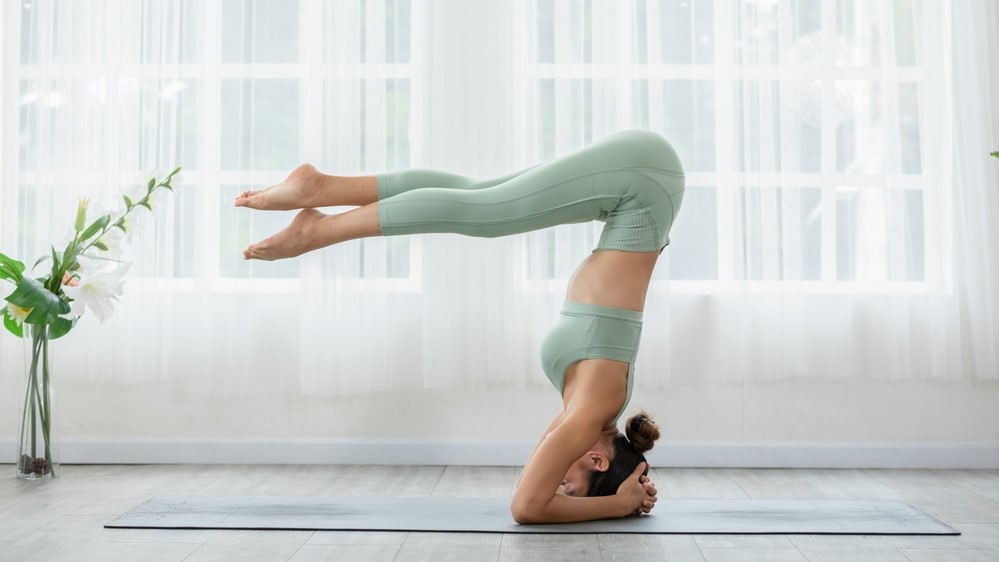I just tried this 21-day 'learn to handstand' challenge — here's what happened
Ready to go head over heels?

Ready to go head over heels? While most people may not make a regular practice of hanging out in handstands, the health benefits and physical reasons for doing so might just make you want to flip out (in a good way).
Personally, though I’ve always been able to get into a handstand, I have never succeeded at holding it for more than two seconds max. This was so incredibly frustrating to me, especially since I’ve had years of dance and gymnastics training, and also earned a 200-hour yoga teaching certification.
I have a strong upper body and great balance, but decided my super flexible back was the reason I would always end up flipping over into a walkover instead of being able to stay inverted. Still, I’d watch people who were able to walk on their hands with envy. It seemed like I should be able to do it too.
So, when I saw the AloMoves 21-day “Learn to Handstand” series, I was intrigued. Could I finally figure out how to hold a handstand and glean all those health benefits for real? I signed up with AloMoves and dove in. Read on to see what happened.
What are the health benefits of doing handstands?
To begin with, in case you were thinking that doing a handstand is purely a “party trick,” there is also evidence that a regular handstand practice can boost your health in very tangible ways, and it may even stave off signs of aging (that got your attention didn’t it?).
A recent study appearing in the journal Frontiers in Medicine in April 2022 concluded that practicing handstands daily for at least ten minutes could lead to better spinal integrity, increased cerebrovascular health (hello, blood to the brain = staying mentally sharp), and even a rejuvenated facial appearance (i.e. delayed wrinkles and minimized eye bags).
Granted, the study participant had been doing handstands regularly for 40 years, but it’s never too late to start. Especially since handstands may also lead to better upper body strength, enhanced balance, improved wrist stability, a boost in mental health (stress relief/increased focus/higher cognition), a tighter core, stronger bones, and more!
Get instant access to breaking news, the hottest reviews, great deals and helpful tips.
Furthermore, because doing handstands challenges the mind and body to accept a position that is literally the exact opposite of the upright way we carry ourselves through life most of the time, it’s also great for increasing mind/body connection and improving kinesthetic awareness.
Suffice it to say, there are a plethora of viable reasons to consider turning your world upside-down.
Another amazing benefit of a handstand practice is that it’s a fully portable, one-move workout. All you really need is you (once you’ve got the technique down).
Keep in mind, however, for those learning handstands, a wall is a huge help! For this AloMoves series, it was also recommended that you have a yoga mat, two blocks, and a yoga strap. I had the first two (mat and blocks) but no strap (though personally, it turned out I didn’t need it).

I tried to learn to handstand in 21 days — here's what happened
So how DO you do a handstand correctly? Time to find out. After signing on to AloMoves, I dropped the “series” into the “My Practice” section of my online account (so I could easily locate it every day) and I got started.
The series, per its name, includes 21 days of handstand instruction. Because learning to handstand requires practice, it’s good not to rush through this program. Handstands are a skill and necessitate not only that you learn the correct technique, but that you also build up the strength to successfully execute the move without landing on your head.
I was actually excited about starting this journey, and that says something since I am someone who already works out daily and knows a great deal about anatomy and exercise principles. I like physical challenges that inspire me but since I’ve tried most workouts at this point, that’s not always easy to find. So this was a fun new way of making me up my game and test my limits.
I instantly warmed to my instructor
As a result of having worked as a fitness instructor and personal trainer myself, I’m also incredibly picky about whom I think is a good teacher. So, don’t take it lightly when I say, I knew within minutes of watching the first video that Briohny Smyth—the lead instructor for the series—is fantastic!
Warm and approachable in demeanor, Bri (as she refers to herself on camera) also delivers cues in a very clear manner and is terrific at explaining physical concepts in very accessible terms. She doesn’t just “lead” workouts, she teaches. My respect for her as an instructor grew even more over the course of this series.
I realized quickly where I'd been going wrong
After watching the quick “How to Approach this Series” video, I started with Day 1, which was “Handstand Drill: Strong Arms.” And I quickly realized I’d been doing a lot wrong with my hands, arms, and pretty much everything.
My first epiphany in the process was that because my elbows hyperextend, I needed to slightly turn out my hands with my index fingers pointing forward instead of my middle fingers. This shift allowed me to get my arms aligned in the best position to actually balance. And discoveries like that continued to happen almost daily. I had more “aha” moments than I can count during the three weeks I was religiously working on handstands every day.
Day 2 was “Handstand Drill: Strong Shoulders” and that’s when I learned I had to sort of shrug my shoulders up towards my ears instead of depressing them. And I had to spread my “wings” (scapula) if I wanted to have breadth across my back to secure the move.
Day 3 was “Essential Handstand Foundations” and again it was chock full of new technique tips that absolutely changed my entire alignment. I’d been kicking up too hard (which makes you automatically arch your back, especially if you have an over-flexible back like mine). Also, it included some terrific exercises like “walking up the wall” to help you find the correct hips-over-shoulders position.
At this point, each “lesson” had only been about 15-20 minutes long and there wasn’t too much practice (a lot of it was watch-and-learn with a few moments to try things yourself). But on Day 4, it was time to start seeing how you might work a handstand into an actual yoga flow with a 43-minute class. It was fun to put it all in play and see how the pieces fit. I wasn’t holding handstands without the wall yet, but I could see the difference already in my approach.
I found the course repetitive
Then we hit Day 5, and I was super confused as I started the lesson for the day because partway into it I found myself thinking “I’ve already done this.” I stopped the video and went back and looked because I thought I’d clicked on the wrong day or something. It was only then I realized that I had done it, but the course repeated lessons on some of the days. So, the lesson for Day 5 was the same class we did on Day 1, the lesson on Day 6 was the same as Day 2, and the lesson on Day 7 was the same as Day 3.
If I have one complaint about the series, it was this, and it’s a minor complaint because this course is excellent. But I counted and there were really only 12 unique classes total if you never repeated. So honestly, this could have been a shorter course.
And while I actually think some repetition is important because I didn’t catch all the technique points the first time through and you need the practice to build strength, some of the classes didn’t need to be repeated.
For example, the same class offered on Day 16 and 20, “Fear to Flying,” was a terrific progression. It addressed the inherent fear that may come with inverting and how to get over it. Great class. But I really only needed that pep-talk once. I also think the “Learn How to Fall” class should have shown up WAY before Day 17 (when I’d already spent two weeks falling). My preference would have been to have all the technique classes taught sequentially before they started repeating anything.
Consequently, what happened for me is that when I got towards the end of the course, instead of listening to what Briohny was saying in a repeated class, I just started working on my handstands by myself. But the positive here is that the only reason I was able to do that was because of all the instruction I had already received by that point and how it had transformed my entire understanding of a handstand.
I tried to learn to handstand in 21 days — my verdict
I loved doing this 21-day challenge and would recommend this course to anyone who is interested in learning how to do a handstand correctly. When I got to the final lesson on Day 21, which was a “Strong Handstand Flow” I was feeling so much more confident than I had been when I started. But what really got me was when during this lovely last yoga flow class led by Bri I caught myself thinking at one point, “I’m not really going to be able to hold that without the wall.”
But then I put all the pieces into place like I’d been taught, and I was suddenly doing it. I was staying up in a handstand, without using the wall. After 21-days, it was super exciting. In fact, so exciting, I then promptly fell out of the move. But for a moment I felt the lightness with control that Briohny had been talking about the whole time. And it was thrilling.
I fully intend to keep practicing my newfound skill daily now, and I also think I’ll go back and revisit some of the early technique classes in this series on the regular just to keep the correct form in mind.
The bottom line, however, is that by this time next year, I hope to be able to stay in a handstand as long as I want. Or maybe I’ll just finally join the circus. But whatever the outcome, I have this high-quality course to thank for completely setting me up for upside-down success.

Kimberly Dawn Neumann is a multi-published writer whose work has appeared in such outlets as Forbes, Cosmopolitan, Fitness, Women’s Health, Prevention, Redbook, Real Simple and more. A Summa cum Laude graduate of the University of Maryland’s College of Journalism, she is also a life coach and fitness professional with certifications from the Coach Training Alliance, the American Council on Exercise, and Yoga Alliance. This NYC-based overachiever has also published two books and performed on Broadway. She meditates twice daily to keep everything in balance.
